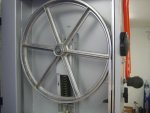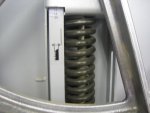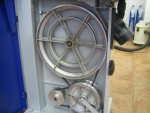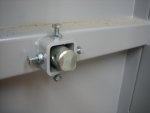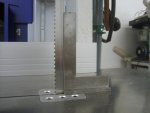Toni Ciuraneta
Member
- Messages
- 5,629
- Location
- Catalunya
All right, now that I'm going to put a US blade in my saw thanks to Larry, I plan to tune it really fine and here is the question.
Acording to "The Bandsaw book" the wheels must be aligned and one way of checking that is using a straight stick and placing it against the wheels and it should touch both wheels at the same tine so that both are turning in the same plane.
However, I noticed that in my saw the previous blade didn't stay on the same part of the lower wheel than in the top one. On the lower wheel is always a bit backward (in the cutting direction).
Due to that I have the feeling that the wheels are not well aligned. Am I right? or it is normal?
Moreover, as the upper wheel is the one that we tilt to adjust the position of the blade on the wheel I guess that to check if both wheels are aligned I should first put the top one plumb (vertical) and check the alignment with the lower one. Is that so? Then I could move the lower wheel backwards for the same displacement that the blade has.
I hope I have explained well what I'm trying to convey.
Any help will be greatly appreciated.
Thanks in advance.
I do want to start fidling around without knowing if what I'm doing is right
Acording to "The Bandsaw book" the wheels must be aligned and one way of checking that is using a straight stick and placing it against the wheels and it should touch both wheels at the same tine so that both are turning in the same plane.
However, I noticed that in my saw the previous blade didn't stay on the same part of the lower wheel than in the top one. On the lower wheel is always a bit backward (in the cutting direction).
Due to that I have the feeling that the wheels are not well aligned. Am I right? or it is normal?
Moreover, as the upper wheel is the one that we tilt to adjust the position of the blade on the wheel I guess that to check if both wheels are aligned I should first put the top one plumb (vertical) and check the alignment with the lower one. Is that so? Then I could move the lower wheel backwards for the same displacement that the blade has.
I hope I have explained well what I'm trying to convey.
Any help will be greatly appreciated.
Thanks in advance.
I do want to start fidling around without knowing if what I'm doing is right






